Practical Challenges of DBT-Guided VABB: Harms and Benefits, from Literature to Clinical Experience
Abstract
Simple Summary
Abstract
1. Introduction
2. Materials and Methods
2.1. Study Design
2.2. Statistical Analysis
2.3. VABB Procedures with Upright System
2.4. VABB Procedures with Prone System
2.5. Side Effects and Troubleshooting
2.5.1. Side Effects
- Vasovagal reaction (0.3%). It manifests as flushing, nausea, feelings of lightheadedness and diaphoresis. Its management usually involves removal of the needle if already positioned while checking the patient’s vital signs, decompression of the breast, then lying the patient down possibly by elevating the lower limbs, applying a cool washcloth to the forehead and neck and ventilating. [21,22]. It is also good practice to consider offering sugary drinks such as fruit juices or soft drinks to quickly combat low blood sugar, especially in case of patients with diabetes [23].
- Bleeding. The risk of significant bleeding hemorrhage is about 0.1% [21]. It can manage with manual compression for about 5–10 min and bandaging which are routinely implemented to reduce the extent of post-procedural bleeding. In particular, in cases of more prolonged bleeding, an elastic compression bandage and a cold ice pack may be useful, as well as the administration of vitamin K, either orally, sublingually or directly at the bleeding site may help reduce the extent of bleeding and stop it. Furthermore, the use of lidocaine with epinephrine for deep anesthesia and biopsy cavity lavage can reduce bleeding [23]. After biopsy, most patients present with superficial ecchymosis due to minor bleeding. In addition, the development of a postprocedural hematoma is a further possible complication, the incidence and severity of which are directly related to the gauge of the needle used. Schaefer et al. [24] classified hematomas as small (within 15 mm), moderate (between 15 and 30 mm) and severe (between 30 and 40 mm). In their experience, they found a rate of small and moderate/severe hematomas of 29% and 12.9%, respectively, when using 8G/9G needles, and of 6% and 2.4%, respectively, when using 11G/12G needles.
- Infection (<1%). It should be limited by avoiding cross-contamination of clean (e.g., mammography unit, DBT equipment) and sterile (e.g., skin, biopsy needle, tissue marker) surfaces by operators as much as possible, using sterile gloves and disinfecting the skin area of the breast subject to collection. If mastitis develops after biopsy, it can usually be managed with oral medications on an outpatient basis [21].
2.5.2. Comorbidity
2.5.3. Patients on Anticoagulant Therapy
2.5.4. Difficult Targets
- Thin breasts. A breast thickness of less than 2 cm can make biopsy difficult. The use of a smaller needle, with smaller aperture, minimizes the risk of posterior skin and/or support plate compromise. Other methods to address this problem include reducing breast compression, building up breast tissue by using towels or gauze against the posterior imaging plate, compression by generating anterior bulging effect, or creating a breast sling by pulling the breast tissue upward and taping the underside when the biopsy is performed in the lateral approach, and finally, the use of lidocaine to develop a wheel at the biopsy entry site [25,31,32].
- Vessels. The use of DBT is useful to identify and avoid vessels along the needle path. Vessels at least 15 mm deep relative to the target may not be a problem. In other cases, an alternative approach may be considered [25].
- Surface targets. A lesion close to the skin presents a unique challenge as the biopsy furrow may not be completely covered by the skin. When the skin is exposed to the groove, the vacuum may pull the skin, resulting in a much larger skin slit and an increased risk of infection [25]. Some steps that can be taken to avoid this problem include choosing a small needle with a smaller sulcus, using a skin hook to pull the skin over the exposed sulcus, and advancing the needle into the breast so that the target is positioned toward the proximal end of the sulcus instead of in the center [25,31,32].
- Posterior targeting. The attachment of posterior lesions is usually facilitated using the upright system, but in any case, lesions close to the chest wall should be targeted in the anterior portion by then trying to take more material toward the chest wall. A mediolateral oblique (MLO) position will allow more posterior and medial tissue to be visualized [31].
- Droopy breasts. Larger breasts can result in slippage effects of the tissues underlying the skin, or displacement of the breast as a result of insufficient traction. This drawback can be recognized in pre-fire images when the target is shown below the needle. In these cases, it is necessary to remove the needle, dry the breast, and perform another attempt using the same approach with increased compression. Alternatively, the approach can be changed to cranio-caudal (CC) projection if possible [25].
- Defective marker release. At the end of the procedure, after releasing the marker, a post-biopsy image with the breast still compressed and the sheath still in place should be taken to confirm correct placement. If no marker is seen, another biopsy marker should be placed. In cases of superficial biopsy or significant bleeding, a biopsy marker may extrude from the breast after the breast has been released from compression [33]. In this situation, it is suggested to put the breast back into compression immediately to place another marker or to place it 2–3 days after the procedure at about 5–10 mm proximal to the end of the hematoma, where the center of the biopsy cavity is expected to be [25].
2.5.5. Biopsy Cancellation
2.6. VABB Procedure at Our Department
3. Results
4. Discussion
5. Conclusions
Supplementary Materials
Author Contributions
Funding
Institutional Review Board Statement
Informed Consent Statement
Data Availability Statement
Conflicts of Interest
References
- Sung, H.; Ferlay, J.; Siegel, R.L.; Laversanne, M.; Soerjomataram, I.; Jemal, A.; Bray, F. Global Cancer Statistics 2020: GLOBOCAN Estimates of Incidence and Mortality Worldwide for 36 Cancers in 185 Countries. CA Cancer J. Clin. 2021, 71, 209–249. [Google Scholar] [CrossRef]
- World Health Organization (WHO). WHO Position Paper on Mammography Screening. WHO. 2015. Available online: https://www.paho.org/en/documents/factsheet-who-position-paper-mammography-screening-summary-recommendations (accessed on 5 July 2023).
- Oeffinger, K.C.; Fontham, E.T.; Etzioni, R.; Herzig, A.; Michaelson, J.S.; Shih, Y.C.; Walter, L.C.; Church, T.R.; Flowers, C.R.; LaMonte, S.J.; et al. Breast Cancer Screening for Women at Average Risk: 2015 Guideline Update From the American Cancer Society. JAMA 2015, 314, 1599–1614, Erratum in JAMA 2016, 315, 1406. [Google Scholar] [CrossRef]
- Tari, D.U.; Santonastaso, R.; De Lucia, D.R.; Santarsiere, M.; Pinto, F. Breast Density Evaluation According to BI-RADS 5th Edition on Digital Breast Tomosynthesis: AI Automated Assessment Versus Human Visual Assessment. J. Pers. Med. 2023, 13, 609. [Google Scholar] [CrossRef] [PubMed]
- Peppard, H.R.; Nicholson, B.E.; Rochman, C.M.; Merchant, J.K.; Mayo, R.C., 3rd; Harvey, J.A. Digital Breast Tomosynthesis in the Diagnostic Setting: Indications and Clinical Applications. Radiographics 2015, 35, 975–990. [Google Scholar] [CrossRef]
- Skaane, P.; Bandos, A.I.; Gullien, R.; Eben, E.B.; Ekseth, U.; Haakenaasen, U.; Izadi, M.; Jebsen, I.N.; Jahr, G.; Krager, M.; et al. Comparison of digital mammography alone and digital mammography plus tomosynthesis in a population-based screening program. Radiology 2013, 267, 47–56. [Google Scholar] [CrossRef] [PubMed]
- Phi, X.A.; Tagliafico, A.; Houssami, N.; Greuter, M.J.W.; de Bock, G.H. Digital breast tomosynthesis for breast cancer screening and diagnosis in women with dense breasts—A systematic review and meta-analysis. BMC Cancer 2018, 18, 380. [Google Scholar] [CrossRef] [PubMed]
- Tari, D.U.; Morelli, L.; Guida, A.; Pinto, F. Male Breast Cancer Review. A Rare Case of Pure DCIS: Imaging Protocol, Radiomics and Management. Diagnostics 2021, 11, 2199. [Google Scholar] [CrossRef] [PubMed]
- Park, H.L.; Hong, J. Vacuum-assisted breast biopsy for breast cancer. Gland Surg. 2014, 3, 120–127. [Google Scholar] [CrossRef] [PubMed]
- O’Flynn, E.A.; Wilson, A.R.; Michell, M.J. Image-guided breast biopsy: State-of-the-art. Clin. Radiol. 2010, 65, 259–270. [Google Scholar] [CrossRef] [PubMed]
- Huang, M.L.; Adrada, B.E.; Candelaria, R.; Thames, D.; Dawson, D.; Yang, W.T. Stereotactic breast biopsy: Pitfalls and pearls. Tech. Vasc. Interv. Radiol. 2014, 17, 32–39. [Google Scholar] [CrossRef]
- Bahl, M.; Maunglay, M.; D’Alessandro, H.A.; Lehman, C.D. Comparison of Upright Digital Breast Tomosynthesis-guided versus Prone Stereotactic Vacuum-assisted Breast Biopsy. Radiology 2019, 290, 298–304. [Google Scholar] [CrossRef] [PubMed]
- American College of Radiology. ACR Practice Parameter for the Performance of Stereotactic/Tomosynthesis-Guided Breast Interventional Procedures. 2020. Available online: https://www.acr.org/-/media/ACR/Files/Practice-Parameters/stereo-breast.pdf (accessed on 5 July 2023).
- D’Orsi, C.J.; Sickles, E.A.; Mendelson, E.B.; Morris, E.A. ACR BI-RADS® Atlas, Breast Imaging Reporting and Data System, 5th ed.; American College of Radiology: Reston, VA, USA, 2013. [Google Scholar]
- Tari, D.U.; Santarsiere, A.; Palermo, F.; Morelli, C.D.; Pinto, F. The management of a breast unit during the COVID-19 emergency: A local experience. Future Oncol. 2021, 17, 4757–4767. [Google Scholar] [CrossRef]
- Lee, A.H.S.; Carder, P.; Deb, R.; Ellis, I.O.; Howe, M.; Jenkins, J.A.; Pinder, S.E. Guidelines for Non-Operative Diagnostic Procedures and Reporting in Breast Cancer Screening; Publication G-150; The Royal College of Pathologists: London, UK, 2021. [Google Scholar]
- Schrading, S.; Distelmaier, M.; Dirrichs, T.; Detering, S.; Brolund, L.; Strobel, K.; Kuhl, C.K. Digital breast tomosynthesis-guided vacuum-assisted breast biopsy: Initial experiences and comparison with prone stereotactic vacuum-assisted biopsy. Radiology 2015, 274, 654–662. [Google Scholar] [CrossRef] [PubMed]
- Ames, V.; Britton, P.D. Stereotactically guided breast biopsy: A review. Insights Imaging 2011, 2, 171–176. [Google Scholar] [CrossRef]
- Scaperrotta, G.P.; Boffelli, G.; Depretto, C.; Di Leo, G.; Liguori, A.; Monaco, C.G.; Borelli, A.; Ferranti, C. Guiding vacuum-assisted biopsy in prone position: Digital breast tomosynthesis vs. stereotactic. Tumori 2022, 108, 326–330. [Google Scholar] [CrossRef] [PubMed]
- Choudhery, S.; Johnson, M.; Fazzio, R.T. Prone Versus Upright Digital Tomosynthesis-Guided Biopsy. AJR Am. J. Roentgenol. 2020, 215, 760–764. [Google Scholar] [CrossRef] [PubMed]
- Shin, K.; Teichgraeber, D.; Martaindale, S.; Whitman, G.J. Tomosynthesis-guided core biopsy of the breast: Why and how to use it. J. Clin. Imaging Sci. 2018, 8, 28. [Google Scholar] [CrossRef]
- Patel, B.K.; Covington, M.; Pizzitola, V.J.; Lorans, R.; Giurescu, M.; Eversman, W.; Lewin, J. Initial experi- ence of tobmosynthesis-guided vacuum-assisted biopsies of tomosynthesis-detected (2D mammography and ultrasound occult) architectural distortions. AJR Am. J. Roentgenol. 2018, 210, 1395–1400. [Google Scholar] [CrossRef]
- Vijapura, C.A.; Wahab, R.A.; Thakore, A.G.; Mahoney, M.C. Upright Tomosynthesis-guided Breast Biopsy: Tips, Tricks, and Troubleshooting. RadioGraphics 2021, 41, 1265–1282. [Google Scholar] [CrossRef]
- Schaefer, F.K.; Order, B.M.; Eckmann-Scholz, C.; Strauss, A.; Hilpert, F.; Kroj, K.; Biernath-Wüpping, J.; Heller, M.; Jonat, W.; Schaefer, P.J. Interventional bleeding, hematoma and scar-formation after vacuum-biopsy under stereotactic guidance: Mammotome®-system 11 g/8 g vs. ATEC®-system 12 g/9 g. Eur. J. Radiol. 2012, 81, e739–e745. [Google Scholar] [CrossRef]
- Chesebro, A.L.; Chikarmane, S.A.; Ritner, J.A.; Birdwell, R.L.; Giess, C.S. Troubleshooting to Overcome Technical Challenges in Image-guided Breast Biopsy. RadioGraphics 2017, 37, 705–718. [Google Scholar] [CrossRef]
- Somerville, P.; Seifert, P.J.; Destounis, S.V.; Murphy, P.F.; Young, W. Anticoagulation and bleeding risk after core needle biopsy. AJR Am. J. Roentgenol. 2008, 191, 1194–1197. [Google Scholar] [CrossRef]
- Melotti, M.K.; Berg, W.A. Core needle breast biopsy in patients undergoing anticoagulation therapy: Preliminary results. AJR Am. J. Roentgenol. 2000, 174, 245–249. [Google Scholar] [CrossRef] [PubMed]
- Patel, I.J.; Davidson, J.C.; Nikolic, B.; Salazar, G.M.; Schwartzberg, M.S.; Walker, T.G.; Saad, W.A.; Standards of Practice Committee, with Cardiovascular and Interventional Radiological Society of Europe (CIRSE) Endorsement. Consensus guidelines for periprocedural management of coagulation status and hemostasis risk in percutaneous image-guided interventions. J. Vasc. Interv. Radiol. 2012, 23, 727–736. [Google Scholar] [CrossRef] [PubMed]
- Patel, I.J.; Davidson, J.C.; Nikolic, B.; Salazar, G.M.; Schwartzberg, M.S.; Walker, T.G.; Saad, W.E.; Standards of Practice Committee, with Cardiovascular and Interventional Radiological Society of Europe (CIRSE) Endorsement. Addendum of newer anticoagulants to the SIR consensus guideline. J. Vasc. Interv. Radiol. 2013, 24, 641–645. [Google Scholar] [CrossRef] [PubMed]
- Patel, I.J.; Rahim, S.; Davidson, J.C.; Hanks, S.E.; Tam, A.L.; Walker, T.G.; Wilkins, L.R.; Sarode, R.; Weinberg, I. Society of Interventional Radiology consensus guidelines for the periprocedural management of thrombotic and bleeding risk in patients undergoing percutaneous image-guided interventions. II: Recommendations: Endorsed by the Canadian Association for Interventional Radiology and the Cardiovascular and Interventional Radiological Society of Europe. J. Vasc. Interv. Radiol. 2019, 30, 1168–1184.e1. [Google Scholar] [PubMed]
- Huppe, A.I.; Brem, R.F. Minimally invasive breast proce- dures: Practical tips and tricks. AJR Am. J. Roentgenol. 2020, 214, 306–315. [Google Scholar] [CrossRef] [PubMed]
- Omofoye, T.S.; Martaindale, S.; Teichgraeber, D.C.; Parikh, J.R. Implementation of upright digital breast tomosynthesis- guided stereotactic biopsy. Acad. Radiol. 2017, 24, 1451–1455. [Google Scholar] [CrossRef] [PubMed]
- Abe, H.; Schmidt, R.A.; Shah, R.N.; Shimauchi, A.; Kulkarni, K.; Sennett, C.A.; Newstead, G.M. MR-directed (“second-look”) ultrasound examination for breast lesions detected initially on MRI: MR and sonographic findings. AJR Am. J. Roentgenol. 2010, 194, 370–377. [Google Scholar] [CrossRef]
- Philpotts, L.E.; Lee, C.H.; Horvath, L.J.; Tocino, I. Canceled stereotactic core-needle biopsy of the breast: Analysis of 89 cases. Radiology 1997, 205, 423–428. [Google Scholar] [CrossRef]
- Verkooijen, H.M.; Peeters, P.H.; Borel Rinkes, I.H.; Pijnappel, R.M.; Kaya, A.; Mali, W.P.; van Vroonhoven, T.J.; COBRA Study Group. Risk factors for cancellation of stereotactic large core needle biopsy on a prone biopsy table. Br. J. Radiol. 2001, 74, 1007–1012. [Google Scholar] [CrossRef]
- Jackman, R.J.; Marzoni, F.A., Jr. Stereotactic histologic biopsy with patients prone: Technical feasibility in 98% of mam- mographically detected lesions. AJR Am. J. Roentgenol. 2003, 180, 785–794. [Google Scholar] [CrossRef]
- Liberman, L. Clinical management issues in percutaneous core breast biopsy. Radiol. Clin. N. Am. 2000, 38, 791–807. [Google Scholar] [CrossRef]
- Park, V.Y.; Kim, E.K.; Moon, H.J.; Yoon, J.H.; Kim, M.J. Evaluating imaging-pathology concordance and discordance after ultrasound-guided breast biopsy. Ultrasonography 2018, 37, 107–120. [Google Scholar] [CrossRef]
- Jörg, I.; Wieler, J.; Elfgen, C.; Bolten, K.; Hutzli, C.; Talimi, J.; Vorburger, D.; Choschzick, M.; Moskovszky, L.; Dedes, K.; et al. Discrepancies between radiological and histological findings in preoperative core needle (CNB) and vacuum-assisted (VAB) breast biopsies. J. Cancer Res. Clin. Oncol. 2021, 147, 749–754. [Google Scholar] [CrossRef] [PubMed]
- Kim, M.J.; Kim, D.; Jung, W.; Koo, J.S. Histological analysis of benign breast imaging reporting and data system categories 4c and 5 breast lesions in imaging study. Yonsei Med. J. 2012, 53, 1203–1210. [Google Scholar] [CrossRef] [PubMed][Green Version]
- Wang, Z.L.; Liu, G.; Li, J.L.; Su, L.; Liu, X.J.; Wang, W.; Tang, J. Breast lesions with imaging-histologic discordance during 16-gauge core needle biopsy system: Would vacuum-assisted removal get significantly more definitive histologic diagnosis than vacuum-assisted biopsy? Breast J. 2011, 17, 456–461. [Google Scholar] [CrossRef] [PubMed]
- Li, J.L.; Wang, Z.L.; Su, L.; Liu, X.J.; Tang, J. Breast lesions with ultrasound imaging-histologic discordance at 16-gauge core needle biopsy: Can re-biopsy with 10-gauge vacuum-assisted system get definitive diagnosis? Breast 2010, 19, 446–449. [Google Scholar] [CrossRef]
- Penco, S.; Rizzo, S.; Bozzini, A.C.; Latronico, A.; Menna, S.; Cassano, E.; Bellomi, M. Stereotactic vacuum-assisted breast biopsy is not a therapeutic procedure even when all mammographically found calcifications are removed: Analysis of 4086 procedures. AJR Am. J. Roentgenol. 2010, 195, 1255–1260. [Google Scholar] [CrossRef]
- Tsai, H.Y.; Chao, M.F.; Ou-Yang, F.; Kan, J.Y.; Hsu, J.S.; Hou, M.F.; Chiu, H.C. Accuracy and outcomes of stereotactic vacuum-assisted breast biopsy for diagnosis and management of nonpalpable breast lesions. Kaohsiung J. Med. Sci. 2019, 35, 640–645. [Google Scholar] [CrossRef]
- Kettritz, U.; Rotter, K.; Schreer, I.; Murauer, M.; Schulz-Wendtland, R.; Peter, D.; Heywang-Köbrunner, S.H. Stereotactic vacuum-assisted breast biopsy in 2874 patients: A multicenter study. Cancer 2004, 100, 245–251. [Google Scholar] [CrossRef] [PubMed]
- Bohan, S.; Ramli Hamid, M.T.; Chan, W.Y.; Vijayananthan, A.; Ramli, N.; Kaur, S.; Rahmat, K. Diagnostic accuracy of tomosynthesis-guided vacuum assisted breast biopsy of ultrasound occult lesions. Sci. Rep. 2021, 11, 129. [Google Scholar] [CrossRef] [PubMed]
- Badan, G.M.; Roveda Júnior, D.; Piato, S.; Fleury Ede, F.; Campos, M.S.; Pecci, C.A.; Ferreira, F.A.; D’Ávila, C. Diagnostic underestimation of atypical ductal hyperplasia and ductal carcinoma in situ at percutaneous core needle and vacuum-assisted biopsies of the breast in a Brazilian reference institution. Radiol. Bras. 2016, 49, 6–11. [Google Scholar] [CrossRef] [PubMed]
- Youn, I.; Kim, M.J.; Moon, H.J.; Kim, E.K. Absence of Residual Microcalcifications in Atypical Ductal Hyperplasia Diagnosed via Stereotactic Vacuum-Assisted Breast Biopsy: Is Surgical Excision Obviated? J. Breast Cancer 2014, 17, 265–269. [Google Scholar] [CrossRef][Green Version]
- Ambinder, E.B.; Plotkin, A.; Euhus, D.; Mullen, L.A.; Oluyemi, E.; Di Carlo, P.; Philip, M.; Panigrahi, B.; Cimino-Mathews, A.; Myers, K.S. Tomosynthesis-Guided Vacuum-Assisted Breast Biopsy of Architectural Distortion Without a Sonographic Correlate: A Retrospective Review. AJR Am. J. Roentgenol. 2021, 217, 845–854. [Google Scholar] [CrossRef] [PubMed]
- Senapati, G.M.; Chikarmane, S.A.; Denison, C.M.; Giess, C.S. Feasibility and accuracy of digital breast tomosynthesis-guided vacuum-assisted breast biopsy for noncalcified mammographic targets. Diagn. Interv. Radiol. 2022, 28, 171–178. [Google Scholar] [CrossRef]
- Azam, S.; Eriksson, M.; Sjölander, A.; Hellgren, R.; Gabrielson, M.; Czene, K.; Hall, P. Mammographic Density Change and Risk of Breast Cancer. J. Natl. Cancer Inst. 2020, 112, 391–399. [Google Scholar] [CrossRef]
- Nazari, S.S.; Mukherjee, P. An overview of mammographic density and its association with breast cancer. Breast Cancer 2018, 25, 259–267. [Google Scholar] [CrossRef]
- Rageth, C.J.; O’Flynn, E.A.; Comstock, C.; Kurtz, C.; Kubik, R.; Madjar, H.; Lepori, D.; Kampmann, G.; Mundinger, A.; Baege, A.; et al. First International Consensus Conference on lesions of uncertain malignant potential in the breast (B3 lesions). Breast Cancer Res. Treat. 2016, 159, 203–213. [Google Scholar] [CrossRef]
- Rageth, C.J.; O’Flynn, E.A.M.; Pinker, K.; Kubik-Huch, R.A.; Mundinger, A.; Decker, T.; Tausch, C.; Dammann, F.; Baltzer, P.A.; Fallenberg, E.M.; et al. Second International Consensus Conference on lesions of uncertain malignant potential in the breast (B3 lesions). Breast Cancer Res. Treat. 2019, 174, 279–296, Erratum in Breast Cancer Res. Treat. 2019, 176, 481–482. [Google Scholar] [CrossRef]
- Neeter, L.M.F.H.; Raat, H.P.J.F.; Alcantara, R.; Robbe, Q.; Smidt, M.L.; Wildberger, J.E.; Lobbes, M.B.I. Contrast-enhanced mammography: What the radiologist needs to know. BJR Open 2021, 3, 20210034. [Google Scholar] [CrossRef] [PubMed]
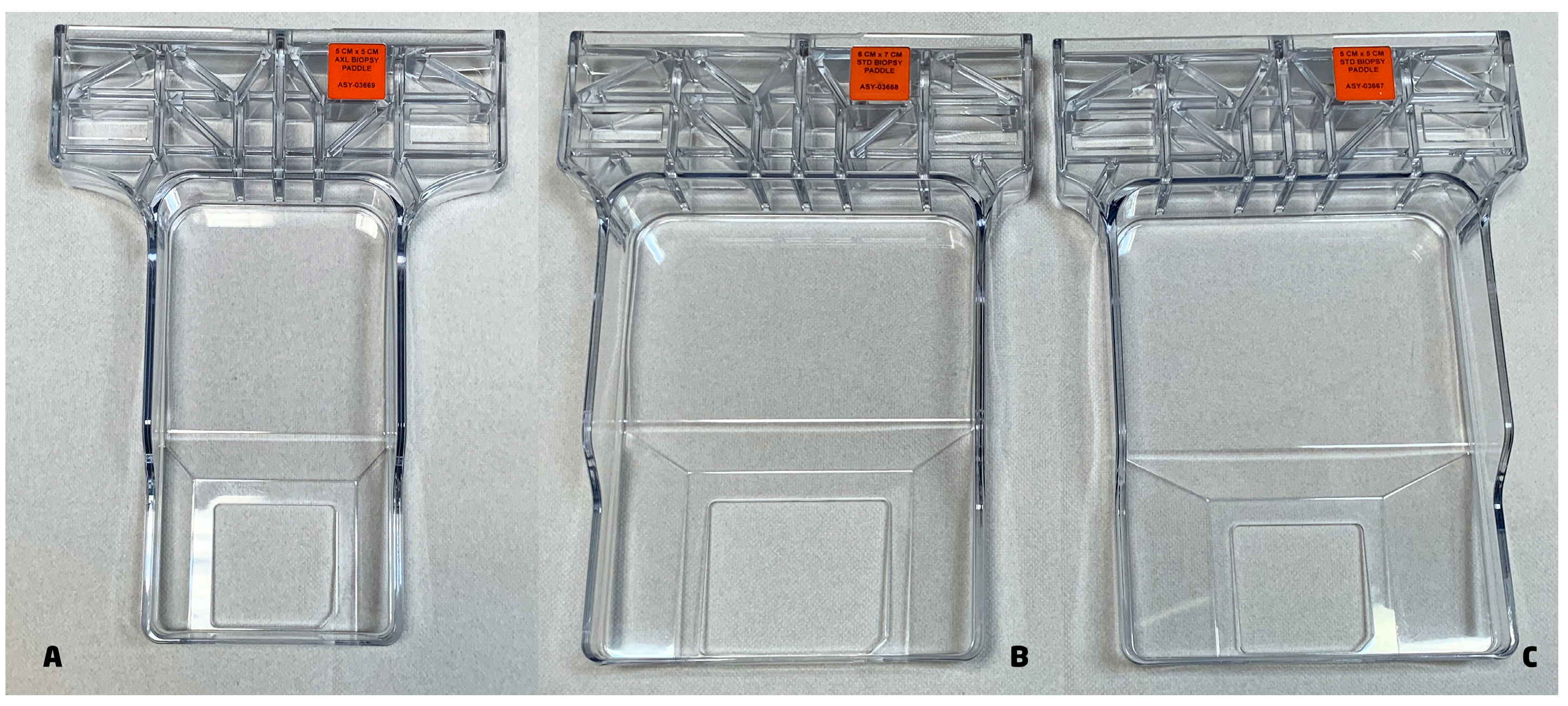
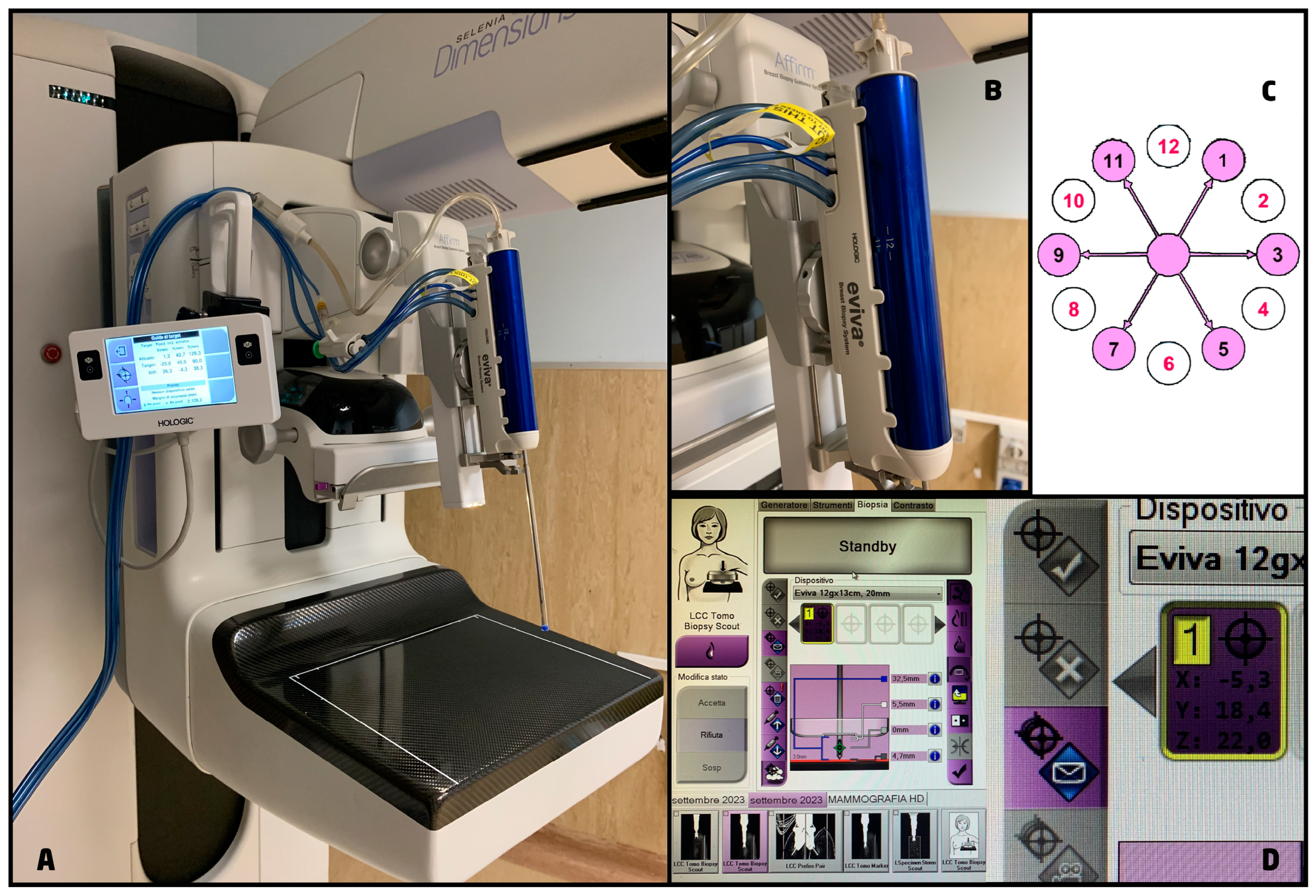
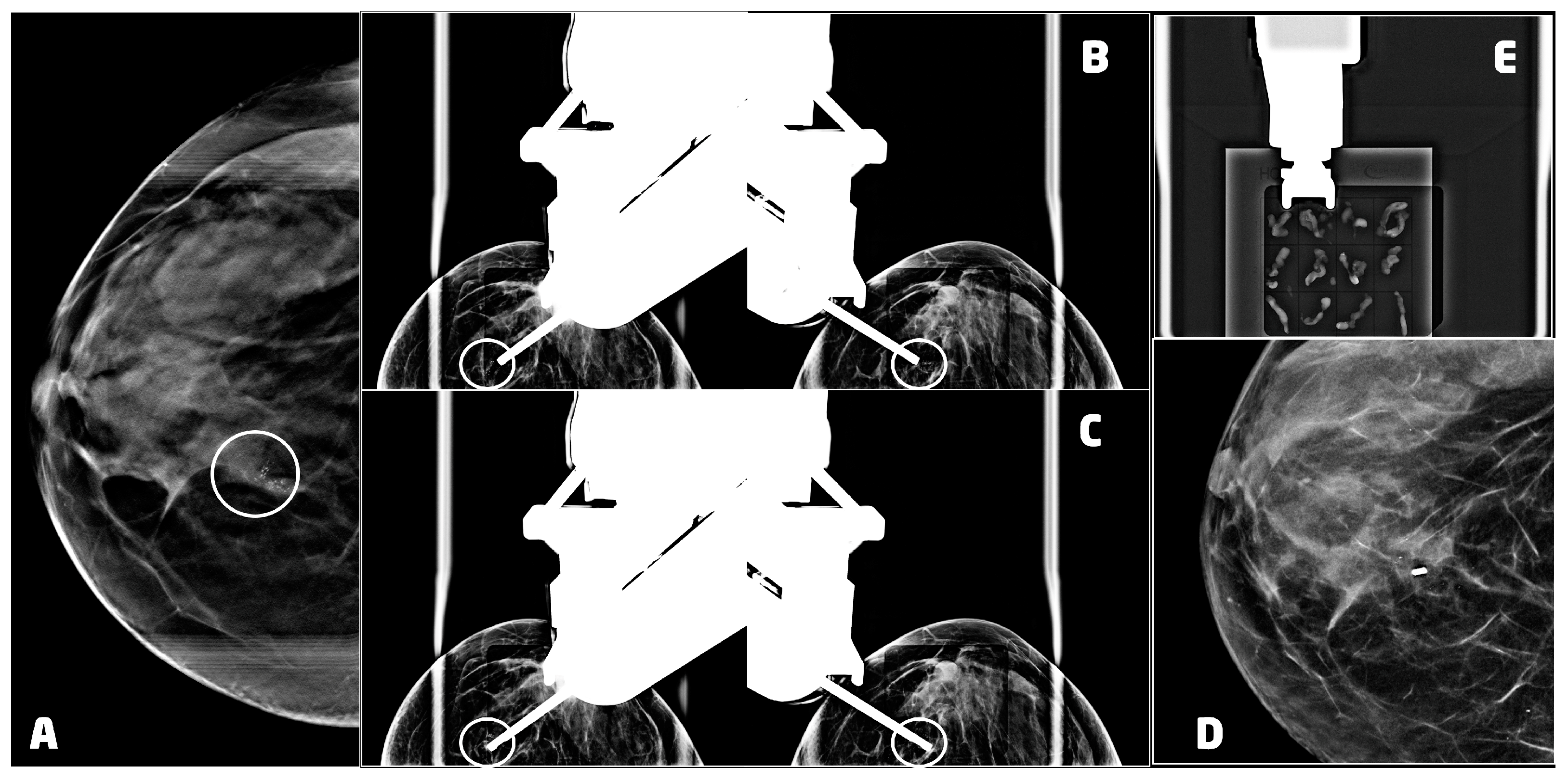
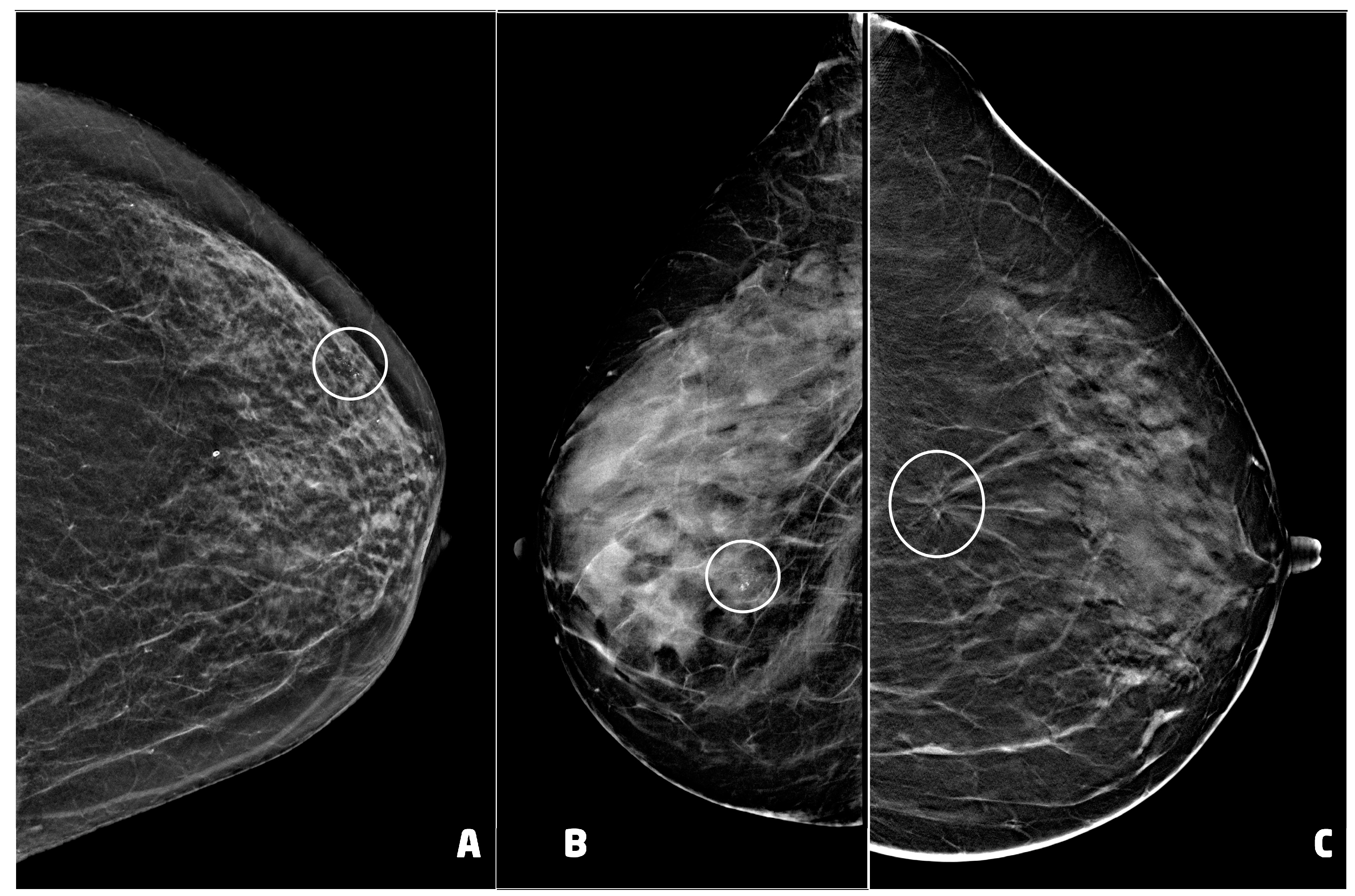
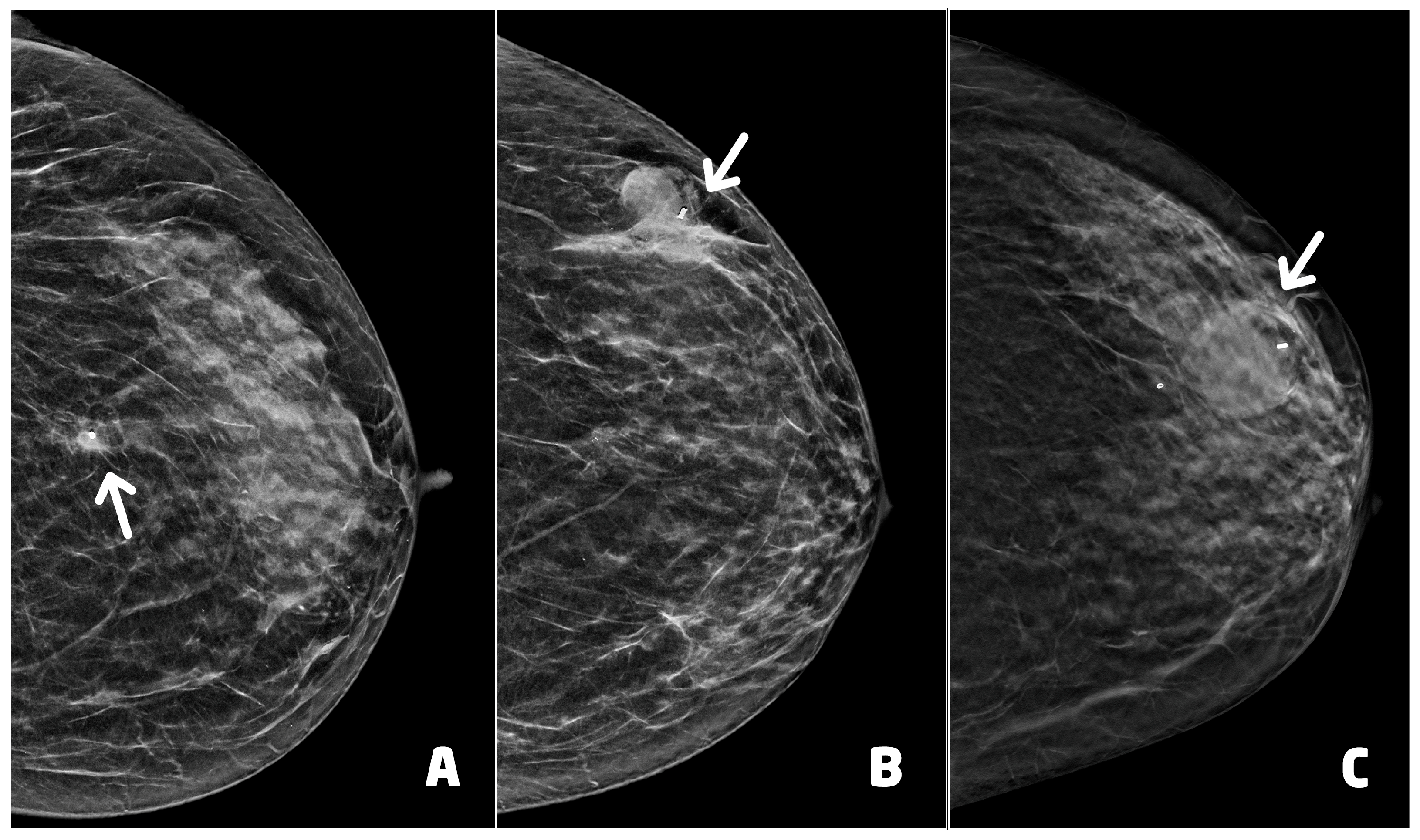
| Breast Cancers: | ||||||||||
|---|---|---|---|---|---|---|---|---|---|---|
| Age | BIRADS | Biopsy | Diagnosis | Grade | TNM | Stage | ER | PgR | Ki67 | Her2 |
| 41 | B4c | B5 | IDC + DCIS | G2 | pT1a pN0 | IA | 90 | 90 | 10 | 1+ |
| 45 | B4b | B5 | IDC | G3 | pT1a pN0 | IA | 0 | 0 | 60 | 3+ |
| 46 | B4a | B5 | DCIS | G3 | pTis | 0 | + | / | / | / |
| 46 | B4b | B4 | IDC tubular | G1 | pT1a pN0 | IA | 90 | 60 | 10 | 1+ |
| 47 | B4c | B5 | DCIS | G1 | pTis | 0 | 40 | 1 | 5 | 1+ |
| 48 | B4c | B5 | DCIS | G1 | pTis pN0 | 0 | + | / | / | / |
| 50 | B4b | B5 | DCIS | G1 | pTis | 0 | + | / | / | / |
| 50 | B4c | B5 | ILC | G1 | pT1b pN0 | IA | 95 | 95 | 3 | 0 |
| 51 | B4c | B5 | DCIS | G1 | pTis | 0 | - | / | / | / |
| 51 | B4b | B3 | DCIS + ADH | G1 | pTis | 0 | + | / | / | / |
| 53 | B4a | B5 | DCIS | G1 | pTis | 0 | 30 | 10 | / | / |
| 53 | B4c | B5 | DCIS | G3 | pTis pN0 | 0 | 80 | 2 | 20 | 0 |
| 53 | B4b | B4 | DCIS | G2 | pTis | 0 | 0 | 0 | 90 | 0 |
| 54 | B4c | B5 | IDC + DCIS | G3 | pT1c pN0 | IA | 90 | 2 | 30 | 2+/0 |
| 54 | B5 | B5 | DCIS | G2 | pTis pN0 | 0 | 40 | 3 | 30 | 3+ |
| 54 | B4b | B5 | DCIS | G3 | pTis | 0 | 0 | 0 | 75 | 0 |
| 55 | B4b | B5 | IDC tubular | G1 | pT1a pN0 | IA | 70 | 60 | 10 | 0 |
| 56 | B4a | B5 | CDIS | G1 | pTis | 0 | + | / | / | / |
| 56 | B4c | B5 | IDC NST + DCIS | G1 | pT1c pN0 | IA | 90 | 70 | 10 | 3 |
| 56 | B4c | B5 | DCIS | G3 | pTis pN0 | 0 | 0 | 0 | / | / |
| 56 | B4b | B5 | IDC | G2 | pT1b pN0 | IA | 90 | 90 | 15 | 0 |
| 57 | B4a | B5 | DCIS + ADH | G1 | pTis pNx | 0 | 80 | 10 | / | / |
| 57 | B4b | B5 | DCIS multifocal | G3 | pTis pN0 | 0 | 0 | 0 | 50 | 3+ |
| 58 | B4a | B5 | DCIS | G3 | pTis pN0 | 0 | 0 | 0 | 20 | 3+ |
| 60 | B4b | B5 | DCIS | G3 | pTis | 0 | 90 | 2 | 10 | 2+ |
| 60 | B4c | B5 | DCIS | G3 | pTis pN0 | 0 | + | / | / | / |
| 62 | B4a | B5 | LCIS | G2 | pLis | 0 | 90 | / | / | / |
| 62 | B4b | B5 | DCIS | G2 | pTis pN0 | 0 | 100 | 100 | / | / |
| 62 | B4c | B5 | DCIS + ADH | G1 | pTis pNx | 0 | + | / | / | / |
| 62 | B4b | B5 | DCIS | G1 | pTis pNx | 0 | 80 | 80 | 2 | 1+ |
| 63 | B4b | B5 | DCIS | G1 | pTis pN0 | 0 | 70 | 70 | 5 | 2+ |
| 66 | B4c | B5 | DCIS | G3 | pTis pN0 | 0 | 80 | 10 | / | / |
| 66 | B3 | B5 | DCIS | G1 | pTis pNx | 0 | 90 | 20 | 10 | 1+ |
| 69 | B4b | B5 | DCIS | G3 | pT1mic pN0 | IA | 90 | 80 | 25 | 1+ |
| 70 | B4c | B5 | ILC | G2 | pT1c pN1mi | IA | 70 | 80 | 25 | 0 |
| 70 | B4b | B5 | DCIS | G3 | pTis | 0 | + | / | / | / |
| 72 | B4c | B5 | DCIS | G3 | pT1mi pN0 | IA | 80 | 20 | 20 | 2+ |
| B3 lesions after surgery: | ||||||||||
| 49 | B4a | B3 | Sclerosing adenosis with CCA and ADH | |||||||
| 49 | B4a | B3 | UDH and ADH | |||||||
| 50 | B4a | B3 | Florid adenosis, UDH and CCA | |||||||
| 53 | B4b | B3 | ADH | |||||||
| 53 | B4a | B3 | ADH with UDH | |||||||
| 56 | B4c | B3 | ADH | |||||||
| 58 | B4c | B3 | Radial scar with atypia and papilloma | |||||||
| 59 | B4a | B3 | ADH | |||||||
| 59 | B4b | B3 | ADH | |||||||
| 67 | B4b | B3 | UDH with ADH | |||||||
| 69 | B4b | B3 | ADH | |||||||
| Type of Exam | Classification of the Findings | Total | Age | Median | ||||
|---|---|---|---|---|---|---|---|---|
| Mammography with DBT | ||||||||
| R3 | R4a | R4b | R4c | R5 | ||||
| 13 | 32 | 23 | 16 | 1 | 85 | 57.2 ± 7.9 | 56 | |
| VABB | ||||||||
| B5 | - | 6 | 13 | 14 | 1 | 34 | 57.1 ± 7.5 | 56 |
| B4 | - | - | 2 | - | - | 2 | 49.5 ± 3.5 | 49.5 |
| B3 | 1 * | 5 | 4 | 2 | - | 12 | 56.5 ± 6.5 | 56 |
| B2 | 12 | 21 | 4 | - | - | 37 | 58.0 ± 8.6 | 57 |
| Surgery | ||||||||
| BC | 1 * | 6 | 15 | 14 | 1 | 37 | 56.5 ± 7.5 | 56 |
| Surgery | |||||
|---|---|---|---|---|---|
| VABB | Benign Findings | B3 Lesions | B4 Lesions | BC | TOT |
| B2 | 36 | 0 | 0 | 0 | 36 |
| B3 | 1 | 11 | 0 | 1 | 13 |
| B4 | 0 | 0 | 0 | 2 | 2 |
| B5 | 0 | 0 | 0 | 34 | 34 |
| Total | 37 | 11 | 0 | 37 | 85 |
| Diagnosis | BD | N. | Age | BD Category | N. | Age |
|---|---|---|---|---|---|---|
| BC (37) | B | 12 | 59.2 ± 7.7 | Non-dense | 12 | 59.2 ± 7.7 |
| C | 19 | 57.2 ± 5.6 | Dense | 25 | 55 ± 7.1 | |
| D | 6 | 53.2 ± 7.6 | ||||
| B3 lesions (11) | B | 4 | 61.2 ± 6.9 | Non-dense | 4 | 61.2 ± 6.9 |
| C | 7 | 53.9 ± 4.4 | Dense | 7 | 53.9 ± 4.4 | |
| Benign (37) | A | 1 | 64 | Non-dense | 15 | 60.8 ± 7.5 |
| B | 14 | 60.6 ± 7.7 | ||||
| C | 19 | 57.3 ± 8.9 | Dense | 22 | 56.1 ± 8.9 | |
| D | 3 | 48.7 ± 1.2 |
| Guidelines for Clinical Practice | |
|---|---|
| Before VABB | |
| (1) | Clinical and familiar history (with particular attention to anticoagulant therapy and allergy to anesthetic drugs) |
| (2) | Evaluation of laboratory tests (PT, PTT, INR, platelet count) |
| (3) | DBT images evaluation (to choose the correct gauge and aperture of the needle) |
| VABB examination | |
| (4) | Full explanations of the procedure (written informed consent; is there psychological stress?) |
| (5) | DBT-VABB procedure a. positioning images b. post-anesthesia images c. pre-fire images d. post-fire images (optional if poor compliance) e. post-clip images (optional if poor compliance) |
| (6) | Bandage with compression |
| (7) | Patient monitoring (at least 10 min) |
| After VABB | |
| (8) | Post-procedure DBT images (LM/ML and CC projections) to evaluate the whole procedure and the correct clip position 2–3 days after the procedure |
Disclaimer/Publisher’s Note: The statements, opinions and data contained in all publications are solely those of the individual author(s) and contributor(s) and not of MDPI and/or the editor(s). MDPI and/or the editor(s) disclaim responsibility for any injury to people or property resulting from any ideas, methods, instructions or products referred to in the content. |
© 2023 by the authors. Licensee MDPI, Basel, Switzerland. This article is an open access article distributed under the terms and conditions of the Creative Commons Attribution (CC BY) license (https://creativecommons.org/licenses/by/4.0/).
Share and Cite
Tari, D.U.; De Lucia, D.R.; Santarsiere, M.; Santonastaso, R.; Pinto, F. Practical Challenges of DBT-Guided VABB: Harms and Benefits, from Literature to Clinical Experience. Cancers 2023, 15, 5720. https://doi.org/10.3390/cancers15245720
Tari DU, De Lucia DR, Santarsiere M, Santonastaso R, Pinto F. Practical Challenges of DBT-Guided VABB: Harms and Benefits, from Literature to Clinical Experience. Cancers. 2023; 15(24):5720. https://doi.org/10.3390/cancers15245720
Chicago/Turabian StyleTari, Daniele Ugo, Davide Raffaele De Lucia, Marika Santarsiere, Rosalinda Santonastaso, and Fabio Pinto. 2023. "Practical Challenges of DBT-Guided VABB: Harms and Benefits, from Literature to Clinical Experience" Cancers 15, no. 24: 5720. https://doi.org/10.3390/cancers15245720
APA StyleTari, D. U., De Lucia, D. R., Santarsiere, M., Santonastaso, R., & Pinto, F. (2023). Practical Challenges of DBT-Guided VABB: Harms and Benefits, from Literature to Clinical Experience. Cancers, 15(24), 5720. https://doi.org/10.3390/cancers15245720








